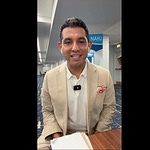July 20, 2025
By Nick Valencia
HIGHLAND PARK — “Do you take American Express?” I asked.
“We take Mexican Express! ¡Órale, a la verga!” the parking attendant shot back.
We were pulling into a parking structure near USC on the way to the LAFC game when the weight of the last six weeks hit me—right in the gut. I let out a big belly laugh. I needed it.
That joke was more than just a throwaway line; it was a reminder of who we are, of the humor and defiance that has always defined Los Angeles’ Latino community. A community that, for weeks, has felt like it was being purged.
The Streets Are Alive Again, Sort of
Traveling back and forth—Atlanta to Los Angeles, Los Angeles back to Atlanta—gives me a perspective that’s hard to shake. On this trip back, I felt a flicker of hope.
A month ago, fear had emptied these sidewalks of Northeast L.A. The ICE raids—carried out with racial profiling so blatant that a federal judge stepped in—had paralyzed the neighborhood. Street vendors vanished. Night markets shuttered. People disappeared into the shadows, afraid of being the next to be mistaken, cuffed, and taken.
But there’s life again on the streets of my neighborhood.
What I witnessed this week is not just the return of tacos on the corner or crowds at the food stands. It’s the slow, stubborn resilience of a people who refuse to let federal agents kill their spirit.
Driving through Highland Park on Friday night, I couldn’t believe my eyes. The glow of taco stands lit up the sidewalks. The lines aren’t what they were before June, but they’re there—people standing shoulder to shoulder, laughing, reclaiming a piece of life that had been stolen. At the exact spot where my taco guy was detained—where the world saw that now-viral footage—a red tent stood with a line of customers.
I told a friend and local resident of Highland Park about what I’d seen.
“Yeah, but don’t make it seem like this is over. This isn’t over. We are still living in this every day,” he said, his tone firm.
He doesn’t see the hope I do.
A Breakfast That Brought Me to Tears
Friday morning, I was having breakfast with another friend, a lifelong Northeast L.A. resident and city observer. As a Latino man born and raised in this city, he has lived through more than I can imagine.
Halfway through breakfast, as we were talking about everything going on, he reached into his pants pocket and pulled out his passport—an unspoken reminder of what it means to live here now. I nodded, then showed him the copy of my birth certificate that I keep folded in my wallet because my mom told me to. This is what life has come to. We used to trade baseball cards—now it’s birth certificates.
Then, without any fanfare, he calmly pulled out another document: his birth certificate. Notarized.
“I don’t have time to mess around if I’m pulled over and they say it’s fake,” he said.
That hit me right in the heart. I felt the tears well up.
Two grown men comparing proof of their own citizenship over coffee in 2025—it felt like a scene ripped from another era, a time we swore we’d left behind. The parallels to the past are sobering.
Why I Can’t Stay Silent
Even a judge’s order—barring ICE from detaining people based solely on the color of their skin—can’t erase the fear that’s been planted. That morning on York Boulevard reminded me why I started doing this work.
Because even a so-called “white-washed” Mexican kid from Northeast L.A.—someone who’s been told he “speaks English so good” when I travel through the South—can be treated like an outsider, like a wetback across the Rio Grande. If that’s true for me, what does it mean for those who have no shield, no papers, and no voice?
The raids have slowed since the court ruling. And while the fear hasn’t completely vanished, I can see this community reclaiming itself.
Órale.











Share this post